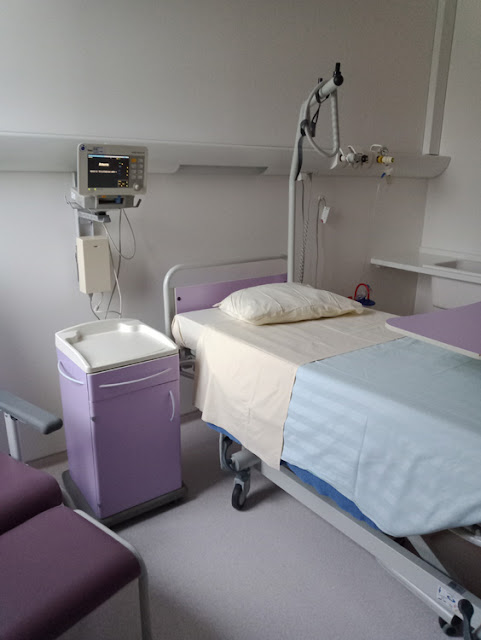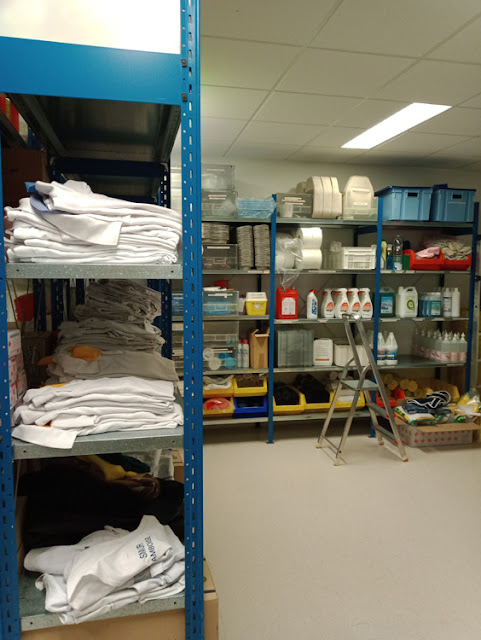No, don't panic. We weren't having an accident or an emergency. Quite the contrary. I was there to meet the Tete d'urgences, Dr Alain Deilgat. This had come about because I received a request from a client who wanted to research some elements of the novel she is writing. Part of the plot involves an ambulance and she wanted to see inside a French ambulance.
 |
| The x-ray room in the Accident and Emergency unit at Amboise Hospital. |
I wasn't at all sure I could organise such a thing, but then I remembered that my friend Antoinette teaches English at Amboise hospital. I put her on the job and she put me in touch with Patricia, the Head of HR at the hospital. Patricia basically did the rest, acting as an intermediary and setting up an appointment with Dr Deilgat for me and my client.
 |
| Patients are monitored in this room before a decision is made to admit them to the hospital or send them home. |
We were warmly welcomed at the Hospital, a medium sized establishment with 100 beds, a psychiatric unit and an accident and emergencies service. Dr Deilgat explained how the service worked, telling us that there were 6 specialist emergency doctors who were rostered on two at a time 24/7. He said they got called out on average about three times a day.
 |
| Patient recovery room. |
First he showed us the various rooms where patients could be x-rayed, monitored, tested and examined. He explained that when someone rang 15, the French medical emergency number, a doctor and nurse would be dispatched in a car filled with medical equipment, known as SMUR. They assess the patient and can treat them, but cannot transport them. If the incident was a car accident, then a big red fully equipped ambulance with driver and paramedic would be dispatched from the fire station. If the incident was domestic then a big white private ambulance with driver and paramedic would be sent. In larger centres, such as Tours, they have SAMU (Service d'Aide Medicale Urgente) vehicles and staff which are similar to the fire brigade ambulances, but based at the big hospitals. Depending on circumstances the doctor and/or the nurse may accompany the patient in the big ambulance on the return journey to the hospital. There are other vehicles known as ambulances, but they are really more like taxis, being private vehicles contracted to transport patients to and from medical appointments and outpatients when necessary.
My client and I found all this fascinating, and we both learned a lot. We were both really impressed at how kind and obliging everyone was. Luckily while we were there no real emergencies happened, but we did get to speak to a teenager who had torn a finger ligament in a rugby game and had been brought in by his mum. And one of the SMUR vehicles and a pompier (fire brigade) vehicle drove off as we arrived. Throughout the visit we all wore masks of course, and Dr Deilgat told us that all patients were tested for Covid in the ambulance. The intake nurse would then send them through one set of rooms if they were Covid free and another set if they had tested positive.
 |
| PPE storeroom. |
Best of all, one of the big white private ambulances turned up to deliver a patient, then very kindly allowed us to peer into the vehicle, ask questions about how the team worked in them, and to take photos.
 |
| Dr Deilgat in the ambulance. |
A big thank you to everyone involved!
 |
| Big white private ambulance. |


2 comments:
You two go the extra mile for your clients, and we blog readers get the benefit. This was fascinating and something we probably wouldn't have learned about anywhere else. Thank you both.
Carolyn: It makes it more interesting for us too, so we are always delighted to do it.
Post a Comment